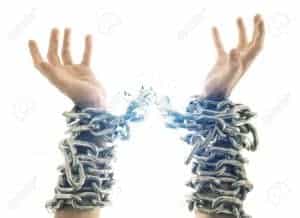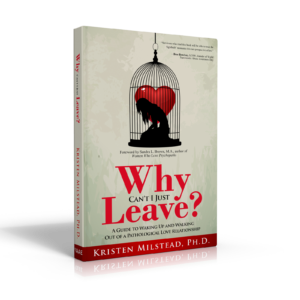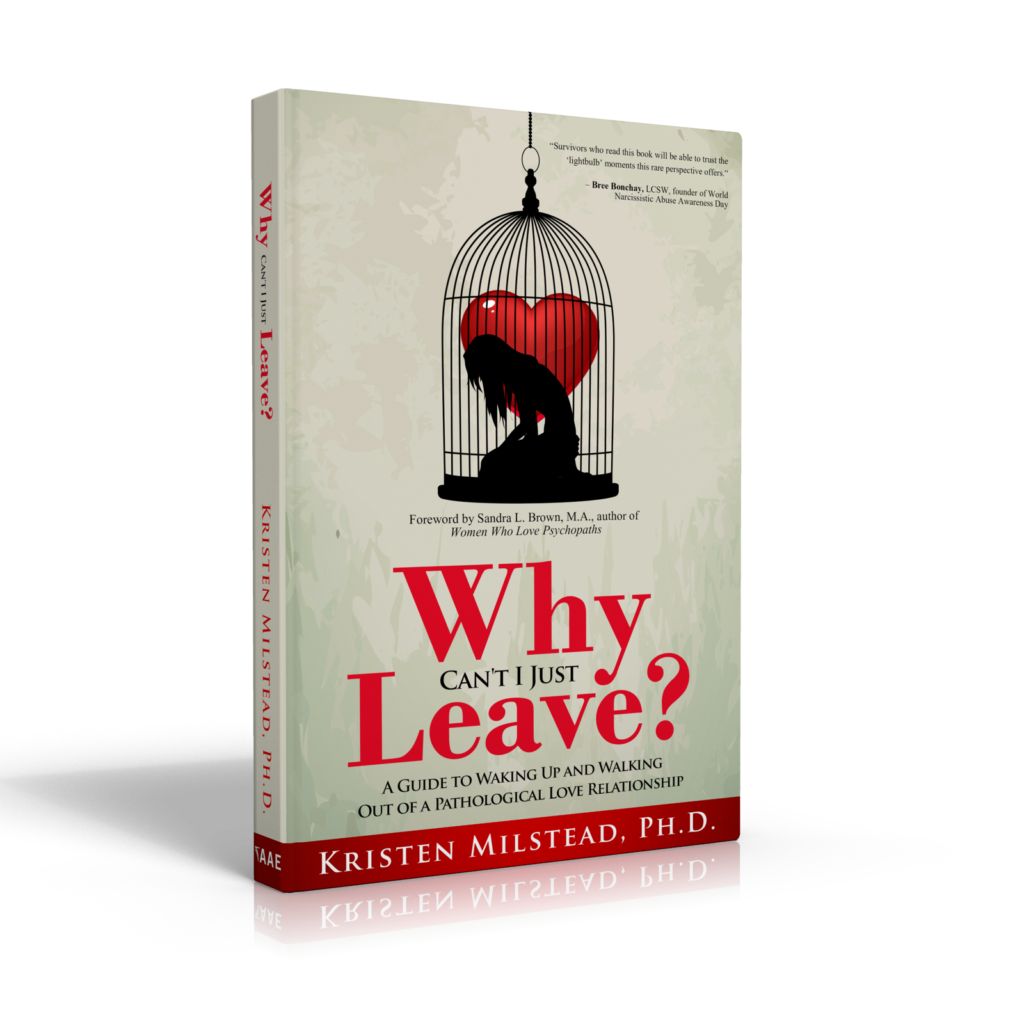We can’t leave a narcissist and go no contact until we go through five stages.
Narcissists lure.
They lure with promises, flattery, lies and sweet words.
[Read Narcissist Love Bombing is Like Poison]
The mask shifts with each new person in their sights, adjusting to our likes and dislikes, filling in crevices to become whatever seems to be missing and fulfilling our long-lost dreams.
What remains the same, however, is that the true nature of the narcissist remains hidden behind the mask.
With that mask, employed skillfully at the outset, the narcissist sets the stage to lure and trap by putting it back on again and again.
[Read Going No-Contact When a You’re a Victim of a Narcissist Discard]
Untouchable. That’s what they want to be.
Imagine the narcissist with a piece of chalk. With the love-bombing they pour on us at the beginning of the relationship, narcissists draw a fat, white circle of protection around themselves.
Their words and deeds during that time further cast a glittering, golden spotlight of goodness over them and we form a bond with the person standing in that spotlight that is difficult to break.
Later, each time they step out of that circle, that is, “cross the line,” and our brain and body scream at us that we have been violated, they only have to stand under the golden goodness inside that circle so we catch them in its glow to get us to override our own instincts.
“No, I’m not abusing you. I love you.”
This is why no one breaks up with a narcissist. They escape.
Breaking up with a narcissist means psychologically changing our view of it to become free.
These are the five necessary stages that give us back our lives.
The difficulty of the journey toward no contact depends on many factors, such as the level of attachment, the length of the relationship, our willingness to give others the benefit of the doubt, our own fears and weaknesses, how hard the narcissist keeps fighting to keep us from leaving, and how deeply the narcissist has obscured the idea that the relationship is abusive behind any of a dozen other smokescreens.
In each of the five stages, our view of the narcissist changes, as well as our view of the relationship itself, until we are either force ourselves out or we are broken down.
[Read The Five Masks of Sanity: How We See the Narcissist]
It takes so long because part of what is so abusive about the relationship is that it hides what is abusive about it from us. When we progress through the stages we gain the enlightenment we need to see the relationship for what it is.
Saving ourselves comes next.
The Five Stages of Going No Contact with a Narcissist
Because of the very nature of how we are abused, the stages through which we progress during a romantic relationship with a narcissist start with the discovery that the relationship is not what we thought it was.
Narcissistic abuse hides the abuse from the partner through elaborate tactics that twist the wrongdoing of narcissists into their victimhood instead of ours.
The abuse leaves us feeling guilty, shameful, afraid, confused, and anxious all at the same time until we are a shadow of ourselves, lashing out when we feel like we’re losing our sanity, freezing when we feel like we’re under attack, and going numb when we should be walking away.
Only through the progression of these five stages can we move from passive participants in the relationship who do what the narcissist wants us to do to active performers in our own lives, who do things that may not be in the best interest of the narcissist– but are definitely in ours. ‘
Only then can we leave the relationship and go no contact.
Stage 1: Awareness of the Narcissistic Abuse
This happens inevitably after the initial phase of the relationship when one has been idealized by a narcissist.
At the beginning of the relationship with the narcissist, things were perfect. We were not yet aware of what was to come. We believed in what the narcissist presented to us because we entered the relationship with good intentions.
At some point, something happens or a series of incidents occur that trigger awareness of the abuse.
We may not yet call it abuse, much less understand that our partner is a narcissist, but these are the moments that lead us to the epiphany that something is terribly wrong. Someone who loves us should not be able to do the horrifying things that were done to us.
Because these are the first glimpses behind the mask and we are bound to the narcissist at least partly if not mostly because of forces beyond our control, we likely enter a state of denial and tell ourselves that this is not what we think it is.
Stage 2: Understanding That the Behavior is Abusive
Reaching the second stage requires coming to understand the nature of what’s happening, that abuse is taking place.
There have been too many incidents. The idealization stage has begun to fade away and we are now so miserable, we have begun to seek answers.
Perhaps we have been talking to others outside the relationship who provided us with an outsider’s perspective. We may have turned to the Internet and stumbled across details about narcissism.
The scope and magnitude of what we are up against, however, have now been planted by this external information. We now have two competing realities: one from the narcissist and one from outside the narcissist that provides us with a new and rational understanding of his or her behavior.
“Understanding,” is not usually the ticket out because it’s merely the bigger picture that is inevitably gained as we seek to make sense of the reality we live in as more of the mismatch between the narcissist’s words and deeds pile up.
At this time, it actually contributes to the cognitive dissonance we feel and now, denial is no longer sufficient as a primary method of managing our understanding of the narcissists’s behavior because the new information we have competes with the narcissist’s “version of events.”
[See The Ultimate Narcissistic Abuse Dictionary to review unfamiliar terms]
Confusion sets in, as the narcissist returns to the white circle dozens of times and we see him or her step out of it just as many, and we now have to choose what to believe about why he or she is doing such things.
Stage 3: Accepting That the Behavior is Destructive

We may remain in Stage #2 for some time, confused.
We try new methods to cope with what’s happening– accepting the blame to try to keep the relationship together, denying that our partner is a narcissist, trying to use what we learned to become more compliant or prove the literature wrong– our relationship will turn out differently, we’ll get through this, we think defiantly.
Eventually, however, progression into Stage #3 generally comes with time, after persistent cruel treatment by the narcissist and our inability to get anything to change and improve.
At this point, the idealization stage is usually so far in the past, we rarely see glimpses of it anymore. Or we have been subjected to so much betrayal and pain, we don’t feel as if we are the same person anymore as we were when the relationship started.
In addition, we have been slowly conditioned not to talk about it or express or process our feelings about what has been done to us.
[Read Word Salad: When Talking is a Narcissist’s Weapon]
We may have lost much of our support system or feel beaten down and our emotions may have slipped long past confusion to defeat. We come to accept that the relationship is bad for us and we need to leave the narcissist.
And yet, we do not because we cannot.
We find ourselves being drawn again and again back into it.
The awareness that we cannot leave causes us additional suffering, as now we know what is happening to us and still we cannot escape. Instead, now not only does the narcissist’s behaviors not match his or her words– ours no longer do either.
Sandra L. Brown, author of Women Who Love Psychopaths, writes that, “…The partners must split in order to stay. In reality, [the survivor] has held two different relationships with the good/bad dichotomous psychopath! Each one of these relationships has required a different belief system in order to remain in it. These belief systems begin to battle each other…”
These two belief systems were drawn out of us slowly over time, using our own strengths and weaknesses against us.
This is the most difficult of the stages to explain in isolation– for how can someone know and accept that a relationship is abusive and desire to leave it, and yet not do so?
Yet the broader context of all the stages, both those that came before and those that come after, and how the relationship has always been about dominance and control by the narcissist can provide most of the answers.
We become paralyzed when our two belief systems are competing with one another and are at the whims of the narcissist.
We begin to develop learned helplessness, in response to being unable to act effectively one way or another in the relationship– either to leave it or to be treated in the manner in which we wished to be treated.
Stage 4: Re-Awakening Eroded Aspects of the Self
This helplessness we develop is created in us over time by the abusive tactics perpetrated by the narcissist. It is an illusion.
Overcoming the acute abusive tactics that keep us confused and helpless is the next stage we need to enter prior to being able to go no contact and leave the narcissistic relationship.
These tactics the narcissist has used to get us to this point include gaslighting, refusal to discuss any of the wrong-doing, blame-shifting, and others.
The tactics keep us under the control of the narcissist. They cause us to feel both incapable and unwilling to begin to tear down the bond that the narcissist developed with us at the beginning, by manufacturing emotions in us.
We feel fear because of the unknown future or what life will be like without the narcissist in our lives.
We feel guilt at doing anything to harm the narcissist, as if we are betraying him or her, and start to think of the good times and good things he or she has done for us. We feel as if we are giving up if we stop trying.
We feel sadness thinking about the loss of the massive presence of that person in our lives if we do anything to remove it.
We feel doubt that we are right about how bad things are, that we are not to blame for how things have turned out, or that we are capable of even doing such a thing.
We feel weak and unable to pull off leaving, knowing it will cause a torrent of emotion and a subsequent range of dramatic responses from the narcissist.
Yet– somehow– despite feeling all of these things, we must overcome them by realizing they are manufactured by what the narcissist has done to us.
They are illusions.
What is real is the anxiety we feel, perhaps in the back of our minds, knowing they will never change or knowing that they can’t ever be faithful.
What is real is the constant “fight or flight” mode we find ourselves in and the nightmares we wake up to due to their explosive tirades we can’t predict. The lies and the gaslighting and our unease and obsessive thoughts.
What is real is the constant questioning and accusations and that persistent feeling we can’t relax into our own lives, that we have lost ourselves a piece at a time and been forced inside a tiny cage until we now live trapped inside of it.
Stage #4 is about letting those emotions and that voice that is carrying them rise closer to the top and override the false emotions that sit in the eroded parts of ourselves where the narcissist has taken up residence and parked his or her own suggestions. Those suggestions serve his or her benefit– not ours.
Overcoming the tactics the narcissist has used to bring us to the point to where we felt we can’t escape means:
- recognizing what they’re doing when they use one of these tactics
- calling out the narcissist when he or she uses them
- not treating the bad behavior they have engaged in throughout the relationship as acceptable just to keep the peace
- not letting any of what they say when they use these tactics help resolve cognitive dissonance in their favor (e.g., believing they are correct when they gaslight and we should doubt our own perceptions, etc.)
- seeing oneself as in control, empowered, and undeserving of this treatment; sometimes this involves “faking it until making it”
This is a turning point in the “enlightenment,” for it is when we begin to gain our control back– and yet it is difficult because nothing will bring it about other than a conscious effort on our parts to stop merely accepting that this is abuse and thinking differently about it.
Other things that happen in the external world may assist with moving us closer to Stage #4.
For example:
Without the narcissist’s influence during a silent treatment, we may begin to think more clearly about what has been going on because the narcissist’s tactics by default will not be of immediate influence.
For example, there will be no gaslighting during this time, so we may be able to start putting things together, or having more empowering thoughts that we don’t want to and shouldn’t let go of if the narcissist reaches out again later.
[Read Narcissist Gaslighting Examples in Romantic Relationships]
Or perhaps our health begins to decline or we suffer another loss in our lives.
Or we may have an epiphany due to an action of the narcissist and realize that, though leaving may result in an emotional crisis for us, a worse fate may result from staying in the relationship.
We may begin to feel ourselves slowly disappearing. We may begin to feel that our lives are stuck. We may begin to feel that we will never get out of the relationship, or that if we do we will never recover from the abuse the narcissist has inflicted on us.
Stage 5: Going No Contact Through Setting an Intention and Psychological Barricade
In Stage #4, the psychological shift is the attitude we have toward ourselves and our ability to do something about what we’ve gone through.
In Stage #5, our mindset changes and we no longer view the narcissist or the relationship the same way. We become ready to tear it all down.
We must actually take actions to remove oneself from the abusive situation physically and psychologically and begin the process of breaking up with the narcissist.
This is where narcissistic abuse recovery truly begins because we have begun to have more control over our own actions despite the fear and guilt we feel at how it will impact the relationship or the narcissist.
The process involves two steps:
- Go completely no-contact with the narcissist forever; and
- Stop idealizing the narcissist and the relationship
[Read How to Get Over a Narcissist: 2 Must-Do Steps]
It is not enough to go no contact.
Shahida Arabi, narcissistic abuse survivor and researcher, says that even though the relationship is toxic, we can get stuck: “If our grief is not addressed, it will get lodged in our brains, our hearts, and our spirits as nostalgia for a man or woman that never existed.”
As alluded to in Stage #4, stating that there is a psychological shift and that we then take action implies that the shift is very black-and-white and that the action is very purposeful.
It implies that there is some dramatic confrontation, as in the movies, where we tell off our partners and walk out the door with all of our belongings never looking back, leaving them speechless and regretful for the way they treated us.
It also implies that everything is suddenly crystal clear and every move we make from here on out is with determination and a sense of self-awareness and direction.
No.
The end is an angst-ridden earthquake, a freefall into a future in which we no longer even know who we are.
The end is a blind spot where they implanted themselves in our psyche, still dictating our actions and monitoring our thoughts for a time even as they are out of our lives.
It’s an emotional roller coaster. It’s a death, fraught with loss and uncertainty.
[Read The Emotional Hell of Going No Contact with a Narcissist]
What Stage #5 does mean is that we pass the point of no return psychologically where we no longer just see the relationship as bad for us, we start to see the narcissist as a disordered person with whom we no longer wish to be in a relationship with.
We are more willing to accept the unknown than to accept the nightmare we have been living.
We choose ourselves.
Want to read more?
Why Can’t I Just Leave? takes you step-by-step through the five stages of leaving a narcissist and helps lead you straight to the exit.
Click here to read a free preview
This isn’t your typical survivor recovery book. When you read it, you’ll learn about:
- What over 600 survivors said about their experiences and how they left their relationships
- 75 signs that you’re in a pathological love relationship
- What makes narcissistic abuse unique
- The most damaging effect of narcissistic abuse
- Why we change while we’re in the relationship
- The five stages of breaking up with a pathological partner
- Pop culture and celebrity examples of narcissistic abuse
- My personal story
Years in the making, this book creates a bridge between the first-hand knowledge of narcissistic abuse by survivors with lived experience and the social psychological research on the interpersonal and group dynamics of high-control relationships.
The heart of the book is explaining why we do things in these relationships we don’t understand and how we can stop.
Available in ebook, paperback, and hardback!
If you’d like to read a free preview, which includes the first chapter and the pathological love relationship checklist, click on this link.
Join the community to get more articles like this one delivered straight to your inbox.
If you like this article, you’ll also enjoy these:
- The Unlucky 13 Different Types of Narcissism
- Idealization and Devaluation: Why Narcissists Flip
- 7 Things That Supercharge Narcissistic Abuse Recovery
- How to Know When a Narcissist is Finished with You
- What Do Narcissists Want?
Sources
Arabi, Shahida. “The Real Reason You Miss the Narcissist.” Thought Catalog. Retrieved May 4, 2019 from https://thoughtcatalog.com/shahida-arabi/2018/02/the-real-reason-you-miss-the-narcissist/
Tudor, H.G. “The Devastation of the Illusion.” Knowing the Narcissist. Retrieved May 4, 2019 from https://narcsite.com/httpnarcsite-com20161011the-devastation-of-the-illusion/











8 Comments
Matthew Joseph Perusco
This is a loving and well stated article. I can only imagine that the book is more detailed and even .ore enlightening. Thank you for sharing this painful, however hopeful message of truth.
God bless you.
K
Good article. Getting over a narcissist is really hard and takes time. Men such as ***** in Finland hide what they are very well. Almost 60 and he is still using, abusing and trashing women. Narcissism cannot be normalised. It is abuse behind closed doors.
Jeannette
Hi
This was very interesting I have a family member with these traits . Can they be helped?
Or are they just born like this? Thank you for posting. J J . WILLS
FEMALE
Carol Z
I have been no contact with my family for 6 years now. I have been no contact with my son for 1 year. I can never get over the feeling of wanting a reconciliation….that they will change their ways, and want to be a family again. And, that my son will “see that he was wrong, and feel bad he abandoned me.” In my head, I KNOW this won’t happen, and if it does, it’s a lie setting me up for more Narc Abuse. But in my heart, I am still filled with grief that I cannot recover from, nor release.
I know I have PTSD. I believe I have healed from it, mostly, but cannot stop the rumination.
My dad died in 2015 and this caused the family split. I stopped being the scapegoat. I have gotten over grieving for my dad. But, I cannot mend from my family. I think about them every day. I can’t find any advice out there as to how to mend my heart and quit longing for them. how to quit reminiscing about the past and our “family,” and how “great” it was. My head is in constant conflict with my heart. Any advice?
Kristen Milstead
Hi Carol, I’m so sorry to hear about what you’re going through. The idea of radical acceptance has helped me a lot. You can google that to read more about it, but it’s basically the idea that we decide we will stop ruminating over the way things should be or should have been, and accept the reality of what they are. When we do that, we become less helpless and feel less like a victim of our circumstances. It doesn’t mean we like what happened or agree with it or condone it. It just means we stop trying to fight with it in our minds, because a lot of our misery comes from not being able to change it. When we just accept that we can’t change it, then we can see it more clearly and start to have a different perspective and think about what we might want to do next. This is just one idea, but, like I said, it’s something that has helped me. Stay strong and take care. -Kristen
Carol Z
I will check that out! I’ve never heard of that concept. THANK YOU SO MUCH! I follow you, and you’re a big help to people like me who have dealt with narcissists. Much Love to you!
Noah Jansing
This is really good.
Nicole Sellin
This is one of the most powerful, accurate articles I gave read up to this point about this subject, and I have read many. The psychological stages are spot on… the nuances of the emotions, the fear, the guilt, even the feelings of anger at myself for not keeping my word and staying gone, like I had promised friends/families I would do. Not only was the narcissist a liar but so was I. And the learned helplessness, the paralysis,I knew I couldn’t remain but I felt too weak to leave. The shame that I had allowed my life to become this sad, small world that I couldn’t bear to be in but was too scared to make changes, and that I kept hope and live alive for a man that deserved neither. And the cataclysmic end, the tsunami washing through and carrying everything away. Now I’m rebuilding…my hope, my confidence, my trust in others and myself, allowing the shift to help me heal and recognize things in him and myself that I didn’t want to see.
Thank you for this❤️❤️❤️